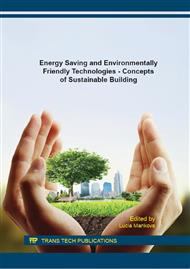[1]
A. Hagishima. J. Tanimoto: Field measurement for estimating the convective heat transfer coefficient of building surfaces. Building and Environment, vol. 38 (2003), pp.873-881.
DOI: 10.1016/s0360-1323(03)00033-7
Google Scholar
[2]
M. G. Emmel. M. O. Abadie. N. Mendes: New external convective heat transfer coefficient correlations for insulated low-rise building. Energy and Buildings, vol. 39 (2007), No. 3, pp.335-342.
DOI: 10.1016/j.enbuild.2006.08.001
Google Scholar
[3]
STN EN ISO 13790: 2008 Energy performance of buildings. Calculation of energy use for space heating and cooling. Bratislava: Slovak Office of Technical Standards, (2009).
Google Scholar
[4]
STN 73 0540-2: 2012 Thermal protection of building. Thermal performance of building and components. Part 2: Functional requirements. Bratislava: Slovak Office of Technical Standards, (2012).
Google Scholar
[5]
STN 73 0540-3: 2012 Thermal protection of building. Thermal performance of building and components. Part 3: Properties of environments and building products. Bratislava: Slovak Office of Technical Standards, (2012).
Google Scholar
[6]
STN EN ISO 13790/NA: 2008 Energy performance of buildings. Calculation of energy use for space heating and cooling. National Annex. Bratislava: Slovak Office of Technical Standards, (2010).
Google Scholar
[7]
STN EN ISO 6946: 2007 Building components and building elements. Thermal resistance and thermal transmittance. Calculation method. Bratislava: Slovak Office of Technical Standards, (2008).
DOI: 10.3403/00942964
Google Scholar
[8]
STN EN ISO 13792: 2012 Thermal performance of buildings. Calculation of internal temperatures of a room in summer without mechanical cooling. Simplified methods. Bratislava: Slovak Office of Technical Standards, (2012).
DOI: 10.3403/30202120
Google Scholar
[9]
Štastný at al.: Modelling of climatic conditions in the annual cycle as a factor significantly influencing the durability of building materials. (In Slovak). RV 05-04-02. Bratislava. SHMÚ, (2005).
Google Scholar
[10]
Test reference year for Bratislava, available from http: /apps1. eere. energy. gov/buildings/energyplus/cfm/weather_data3. cfm/region=6_europe_wmo_region_6/country=SVK/cname=Slovakia%20(Slovak%20Republic).
Google Scholar
[11]
EN ISO 15927 Part 1 – Part 6, Hygrothermal performance of buildings - Calculation and presentation of climatic data, (2003).
Google Scholar


